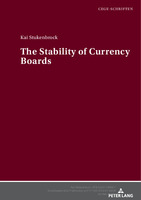The Stability of Currency Boards
Abstract
The 1990s saw a revival of the currency board system, and proponents have advocated it as an easy-to-set-up exchange rate arrangement providing effective stabilization of the economy. However, the experience of Argentina has highlighted the risks of having a currency board. This study presents both the potential benefits, as well as the risks, of having a currency board by examining the stability of the currency board arrangement and identifying factors affecting the stability. The analysis is based on second-generation currency crisis models, extended to incorporate currency-board specific features and to account for particular aspects often found in currency-board economies.
Keywords
Argentina; Boards; Currency; Currency Board; Currency Crisis; Estonia; Exchange Rate; Foreign-Currency Debt; Hong Kong; Lithuania; Stabilitätspolitik; Stability; StukenbrockDOI
10.3726/b14167ISBN
9783631756997OCN
1083018451Publisher website
https://www.peterlang.com/Publication date and place
Bern, 2018Series
cege-Schriften, 8Classification
Politics and government
Economic theory and philosophy
Monetary economics
Economic history


 Download
Download